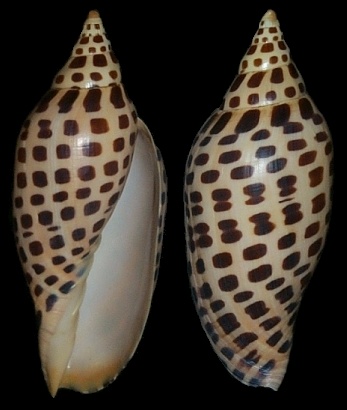| Off-loading The "Lady Barbara" |
| By Bill Frank |
 With visions of wonderful conchological discoveries dancing in your head, you drove many hours to the Florida Panhandle scallop dumps. Upon arrival you were awed by the presence of 1/2 acre lots piled 12 feet high with scallops. With great expectations, you began digging. Unfortunately, you soon discovered that you spent a lot of time digging and found few shells of interest. How is this possible? Why so few shells other than scallops? On a recent trip to Carrabelle in the panhandle I was able to participate in the off-loading of the "Lady Barbara," an approximately 65 foot South Carolina-registered, former Port Canaveral, scallop trawler. This experience helped to partially explain the aforementioned lack of shells in certain dumps. The "Lady Barbara" had trawled offshore overnight before returning to port at daybreak to be off-loaded. The entire aft and mid-ships sections of the vessel were loaded to near the gunnels with dredged material. Never having seen an off-loading up close, I approached one of the workers at the scallop plant and inquired if I might watch. Luckily, the individual not only consented but turned out to be a "trash man;" one who separated the trash (fish, shells, rocks, etc.) from the scallops. After further conversation, he and his two co-workers agreed to hand me, standing below their work stations, all the shells other than scallops which came down the conveyor belts. The procedure for off-loading was to remove the scallops from the deck of the boat with a clamshell bucket and drop them into a large hopper which fed two belts for the "trash men." They then removed the material other than scallops and placed it on the trash belt. The scallops normally would then go into the plant for processing and finally out of the plant into a truck waiting for the now empty shells. The trash belt fed directly into a waiting dump truck. In this particular instance, the scallops were to be processed at another facility and were thus loaded into an 18-wheeler while the trash went directly to a truck to taken to the off-loading facilities scallop dump. The processed scallop shells would ultimately be dumped by the plant which extracted the meats from the now culled material. Fortunately, as soon as off-loading had gotten underway, the diesel engine powering the clamshell off-loader developed problems necessitating about an hour's repairs. During this period I was able to closely examine the dredged material. It didn't look promising until a five inch plus Scaphella junonia was seen crawling across one of the few remaining portions of exposed deck. Upon being asked, the trawler crew readily granted me permission to come aboard and look around. When notified of this wayward spotted shell, they gladly gave it to me and said I could have anything other than scallops from the mass of writhing sea bottom on the deck. After about 30 minutes of wading and poking around in the dredged material, the take was only four S. junonia, two Cinctura hunteria forms, a couple of small Busycon perversum, and two dead paired Macrocallista maculata. Not much of a haul considering that it was exactly as it was taken from the ocean bottom and had not been culled by the crew other than to remove a large Triplofusus giganteus and five massive Busycon perversum; all destined for the cooks pot. Soon the diesel engine was repaired and the off-loading began anew. In less than two hours it was all over. Only two additional S. junonia had been found in addition to a few other common shells. While it appeared likely that during the hectic pace of off-loading the trash belt workers overlooked some shells, especially smaller species and bi-valves, less than 20 shells had been found in the several tons of dredged material. If you wanted sand dollars, it was a treasure trove but if you wanted shells if was a big disappointment. As has been observed in other non-culled dump sites, or sites where the trash was dumped with the processed scallop shells, the most common find other than scallops was S. junonia. From this experience, the easy answer as to why there are few shells of interest in the dumps is simply that they are not being trawled along with the scallops. Also, the trawled material may have been culled by another facility and the by-catch, such as S. junonia, was dumped elsewhere. Similarly, the dredged material may have been culled by the "trash men" and the by-catch shells were given to or sold to an interested party. Do you want to find shells without straining your back? Then find the dirtiest, most odoriferous dump with rotting fish, crabs, skate, etc.; and you should have one that contains both the processed scallop shells and the by-catch. Happy shelling! *One of the Scaphella junonia collected during the off-loading process was returned to Jacksonville and placed in an aquarium where it lived for another year and a half. |